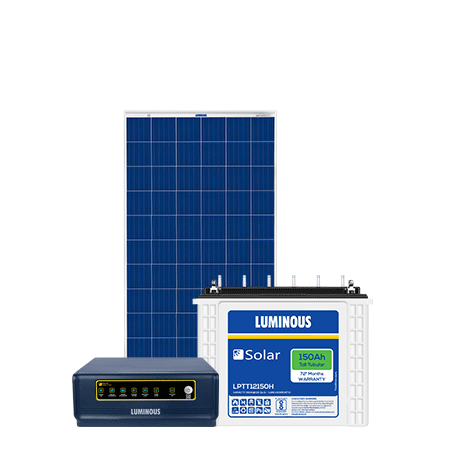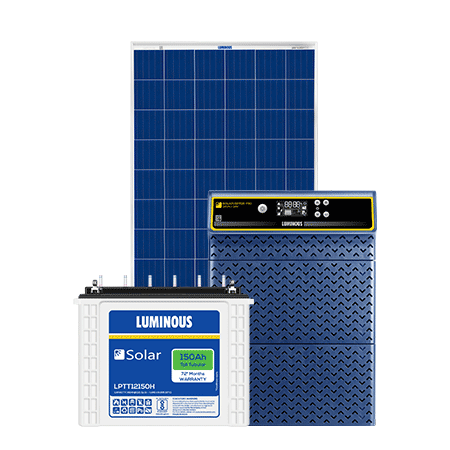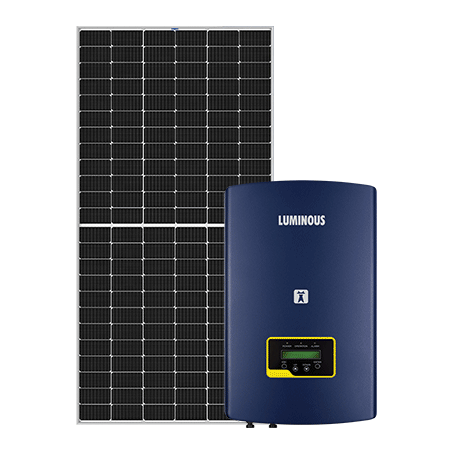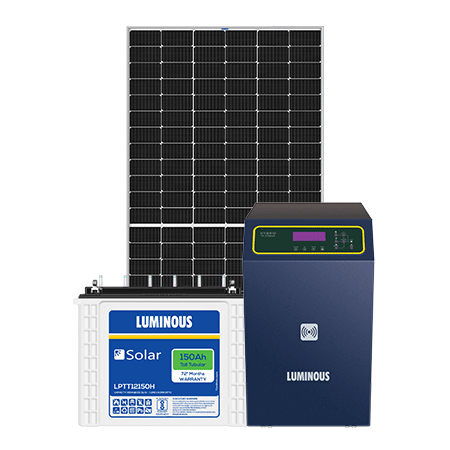
Power Solution
You can get a complete range of solar solutions under one roof – choose from our vast bouquet products. There are different kinds of solar systems you can choose from — Off Grid Solar Solution Combos, On Grid Solar Solution Combos, Hybrid Solar Solution Combos.


 User Friendly LCD Display
User Friendly LCD Display Faster Battery Charging (90V)
Faster Battery Charging (90V) Max PV Capacity Utilization
Max PV Capacity Utilization User Settable Priority Modes
User Settable Priority ModesIf your area is troubled with frequent power cuts, it’s time you invest in an off-grid PWM Based solar system. It is a cost-effective solution that lets you save extra solar energy in batteries to use during power cuts. The PWM-based solar system with a battery offers the best in class conversion efficiency.


 Max PV Capacity Utilization
Max PV Capacity Utilization Wi-fi and remote monitoring
Wi-fi and remote monitoring Flexibility to use different types of batteries
Flexibility to use different types of batteriesSay goodbye to frequent power cuts with off-grid MPPT-based solar systems. This system is highly efficient for areas which suffer from frequent power cuts by storing extra solar energy in the batteries. The Luminous MPPT-based solar system with a battery has excellent conversion efficiency. With the help of pure sine wave output, this solar system can provide high efficiency in running appliances.


 Anti-islanding Protection
Anti-islanding Protection IP65 Protection
IP65 Protection Wi-fi and remote monitoring
Wi-fi and remote monitoringThis system consists of a grid-tie inverter and solar panels. Luminous grid-tied solar systems without batteries are a safe, reliable and efficient solution to use solar power to run home appliances and export extra solar power generated to grid, helping in reducing your electricity bills.


 User Settable Priority Modes
User Settable Priority Modes Advanced Anti-islanding Protection
Advanced Anti-islanding Protection In-built Zero Export Function
In-built Zero Export Function Works like both Solar PCU & GTI
Works like both Solar PCU & GTIGet the functionality of both on-grid and off-grid solar solution in our hybrid solar solution combos and experience the most reliable, efficient and powerful performance you can ever have. These type of solar solution combos can store the power in batteries to run your appliances during power cut as well as export excess solar power generated to grid. It also comes with in-built zero export function which enables this combo to work even in ...
What are the essential components of a solar power system?
There are several important components that you need to know about before investing in a solar energy system for home:
• Solar PV Panels:
A solar panel comprises of small photovoltaic cells which helps convert sunlight into electricity. The cells are made of silicon which are effective at conducting electricity while being able to maintain the electrical imbalance necessary to create electrical fields.
• Solar Inverter:
A solar inverter is an electrical converter which aids in converting the direct current (DC) output from the solar panels into alternating current which is then used to power all of the home appliances. Moreover, it helps in storing any extra solar energy that’s generated in the solar battery to be used in case of a power outage, or you can also feed it to back to the electrical grid resulting in less energy bills.
• Solar battery:
A solar battery is the energy storage unit of a solar system for home and acts a reserve whenever power backup is required. A solar battery can be designed both for short or long power cuts and are available across a range of power specifications.
I live in a region with high power cut, which type of solar system should I go for?
Opt for off-grid solar power systems. These systems store the electricity produced by conversion in batteries and utilise the stored energy by converting it back to AC so that you can keep running you appliances during power cuts. It's a boon if you are living or planning to live in an area with no mains connectivity. The rising cost of other power sources as well as of and the increasing demand of electricity, especially in high power cut or no grid areas, has resulted in increased demand for such systems. The reduction in battery prices over the years has further brought the system cost down. But if you don't have a power cut issue, then we suggest you go for an on-grid system as it will help you save big on your electricity bill.
Is it worth installing a solar system to power all my electrical equipment and completely cutting off power supply from the grid?
Installing a rooftop solar PV system is any day a wise choice. It will help you to reduce your monthly electricity bill. But going completely off power from the grid might not be the best thing to do. Why? If you completely cut-off from grid, then you will be needing batteries for storing the light energy that is converted into electricity. This energy then shall be re-converted for use and it is here that efficiencies of conversion come into play. Also batteries increase cost as they need to be replaced every 4-5 years and require maintenance. A grid-tied solution with net- metering is perhaps a better choice. You can enjoy all electricity generated by panel during day time and during night time, you can take power from grid. The math therefore is simple. A system with storage or an off-grid system requires a higher outlay of money owing to the batteries. For complete autonomy an even higher one!Whereas, with a Grid-tied or an On-grid system you have a choice of power sources your own Solar Power Generation System or the Grid. If you consume more than you generate, you pay for the excess units. On other hand, if you generate more than you consume then you get paid for the excess units.
Do we get any subsidy/tax benefits for installing solar?
Absolutely, In case of rooftop Grid-Tie solar power system, the owner must complete all the necessary requirements for getting net-meter installed. This may require additional time and fees depending on the local electricity utility. Any good service provider will assist you fully in the process. For battery based systems, no permits are required. However, in case there are subsidy schemes offered by local government, additional documentation may be required for subsidy. Luminous products are designed as per IEC standards, and are eligible for subsidy schemes. Ministry of New and Renewable Energy (MNRE) announces subsidy and its disbursement procedure on its website regularly, you may pay them a visit as well to know more.
Is there a single type of solar solution that serves for all requirements?
There are broadly two types of rooftop systems that you will hear about -On-Grid solar power system - These systems are designed to work in conjunction with the grid or simply put your electricity supply. The electricity you generate using this system is fed back to the grid. A net meter is installed along with this system to keep track of the electricity consumed by you versus what you generated and fed back to the grid resulting in savings which gets reflected in the bill. It does not work when the grid is down. Off-grid solar power system - These systems store the electricity produced by conversion in batteries and utilise the stored energy by converting it back to AC as and when required. The rising cost of other power sources and the increasing demand of electricity, especially in high power cut or no grid areas, has resulted in increased demand for such systems. The reduction in battery prices over the years has further brought the system cost down.